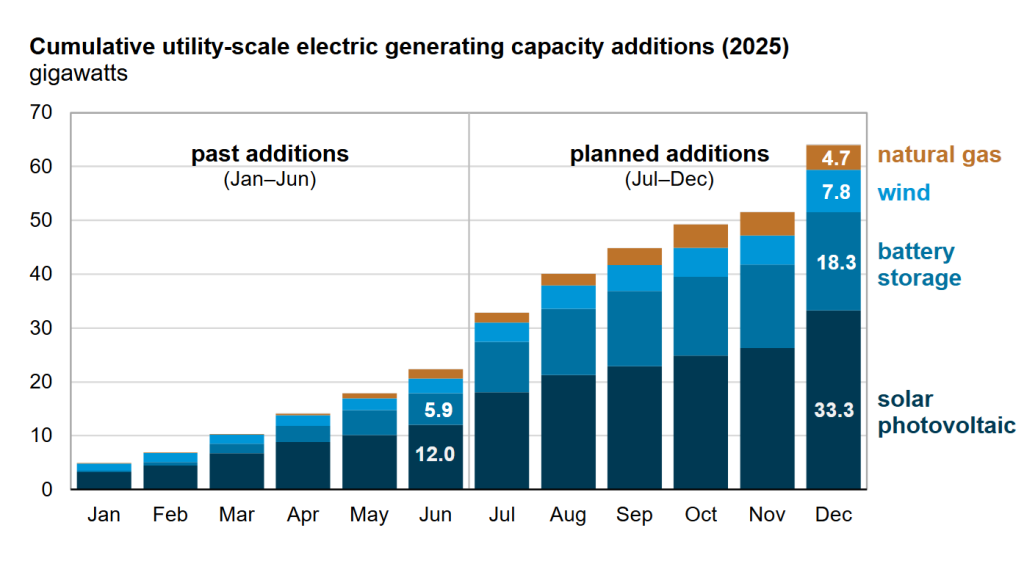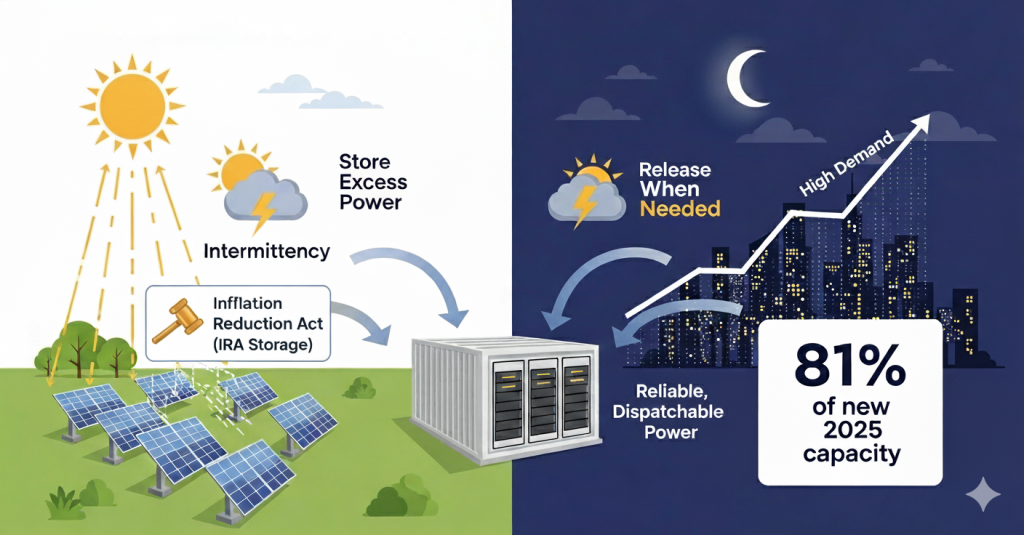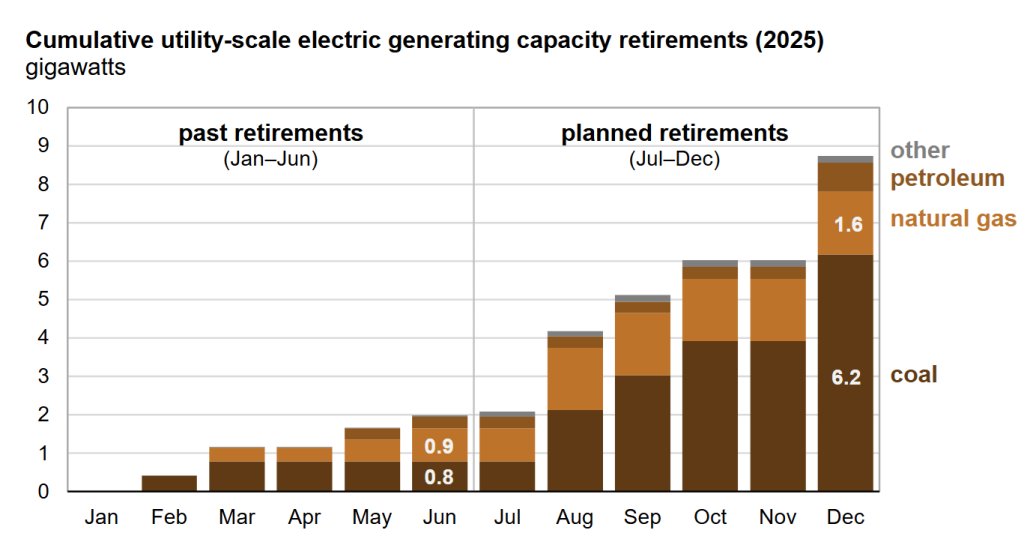The largest change in the history of the US electrical grid is scheduled to occur in 2025. With the addition of 64 gigawatts (GW) of new utility-scale power capacity, developers intend to make this the most significant expansion in a single year in American history. Unlike the natural-gas-driven boom of 2002, this time the growth is fueled by solar power and battery storage, marking a new era for the nation’s energy mix. This US solar power surge highlights how clean energy is taking the lead in shaping America’s future electricity system.

Source: U.S. Energy Information Administration, Preliminary Monthly Electric Generator Inventory, June 2025
What’s Driving the 64 GW Capacity Boom in 2025?
The U.S. Energy Information Administration (EIA) projects that:
- Solar power will lead with 33.3 GW, more than half of all new additions, underscoring the momentum behind the US solar power surge.
- Battery energy storage systems (BESS) will add 18.3 GW, nearly double the record set in 2024.
- Wind power will contribute 7.8 GW.
- Natural gas, once dominant, will add just 4.7 GW.
This shift shows how clean energy technologies have overtaken fossil fuels in both cost and scalability.
Also Read: Solar Policy In Flux As Grid Costs In US Challenge Clean Energy Growth
How Do Solar and Storage Work Together?
One of solar’s biggest challenges is intermittency: power peaks during the day and drops to zero at night. That’s where battery storage comes in.
- Batteries store excess daytime solar power and release it in the evening when demand is high.
- This makes solar a reliable, dispatchable resource, not just “use it when the sun shines.”
- The Inflation Reduction Act (IRA) of 2022 added a standalone tax credit for storage, encouraging large-scale deployment.

Solar and storage make power last longer as batteries save daytime energy to light up nights, driving 81% of new U.S. capacity in 2025.
Together, solar and storage make up 81% of planned new capacity in 2025, demonstrating that the U.S. is not only adding renewables but also building a new kind of grid.
Also Read: 1410 GW Solar Output Curtailed In India Since 2019, Industry Presses MNRE For Policy Intervention
Why Is Texas Leading the Solar and Storage Revolution?
Texas has become the epicenter of America’s renewable boom, with nearly 13 GW of solar and 7 GW of storage planned for 2025. That’s about 40% of the nation’s new solar capacity and 38% of storage additions.
Why Texas?
- High solar potential and ample land for large-scale projects.
- A unique energy-only market (ERCOT) that creates strong price signals for storage.
- Surging electricity demand from population growth, industries, and data centers.
- Faster permitting and interconnection compared to other states.
Interestingly, this boom isn’t driven by politics; Texas remains a stronghold in the oil and gas industry. Instead, it’s pure market economics: solar-plus-storage is simply the cheapest and fastest way to meet rising demand.
Also Read: Top 5 Solar Batteries For Home In 2025: Performance, Lifespan & ROI Compared
How Is the Rest of the Energy Mix Changing?
As renewables rise, fossil fuels are shrinking:
- 8.7 GW of capacity will retire in 2025, mostly coal (71%).
- Some retirements are delayed because older plants continue to provide essential grid services, such as voltage support and backup capacity.
- Still, the US solar power surge continues to push ahead. In 2024, the U.S. added 36 GW of solar energy, and 2025 is on track to exceed this by another 33 GW, far surpassing what was previously possible.

Source: U.S. Energy Information Administration, Preliminary Monthly Electric Generator Inventory, June 2025
This trend illustrates how renewables are steadily displacing fossil fuels, although the transition necessitates a balance between reliability and decarbonization.
What Challenges Could Slow the Momentum of Solar Energy?
Even with the US solar power surge, several roadblocks could limit growth:
| Challenge | Impact on US Solar Power Surge |
|---|---|
| Grid bottlenecks | Over 1,000 GW of projects are stuck in interconnection queues; transmission upgrades may take a decade, slowing expansion despite the surge in demand. |
| Supply chain risks | Heavy reliance on imported solar panels and battery materials makes the surge vulnerable to global trade disputes. |
| Policy shifts | Changes in state-level net metering, permitting, and siting rules could delay projects and weaken the benefits of the surge. |
Also Read: How To Choose The Best Solar Generator For House Backup During Power Outages
FAQs
Q: Is the 33 GW solar forecast guaranteed?
Not guaranteed, but highly likely. It’s based on developers’ reported plans to the EIA. Delays may push some projects into 2026, but momentum remains strong, with 12 GW already installed in the first half of 2025.
Q: How does battery storage help solar?
Storage absorbs cheap solar power during the day and delivers it in the evening. This prevents energy waste, reduces price spikes, and makes solar more reliable.
Q: Will consumers see lower electricity bills?
Wholesale prices could drop since solar energy has no fuel costs, but grid upgrades and storage investments may offset these savings. The impact will vary by region and utility.
Q: Besides tax credits, how does the IRA support solar?
The IRA provides 10 years of policy certainty, boosts domestic manufacturing, and expands access to tax credits through flexible financing tools.
Q: What’s the biggest bottleneck for U.S. solar growth?
The grid itself. Transmission lines and interconnection delays are the most significant barriers, not the cost of solar or batteries.
Also Read: Community Solar Gardens: Everything You Need to Know


0 Comments